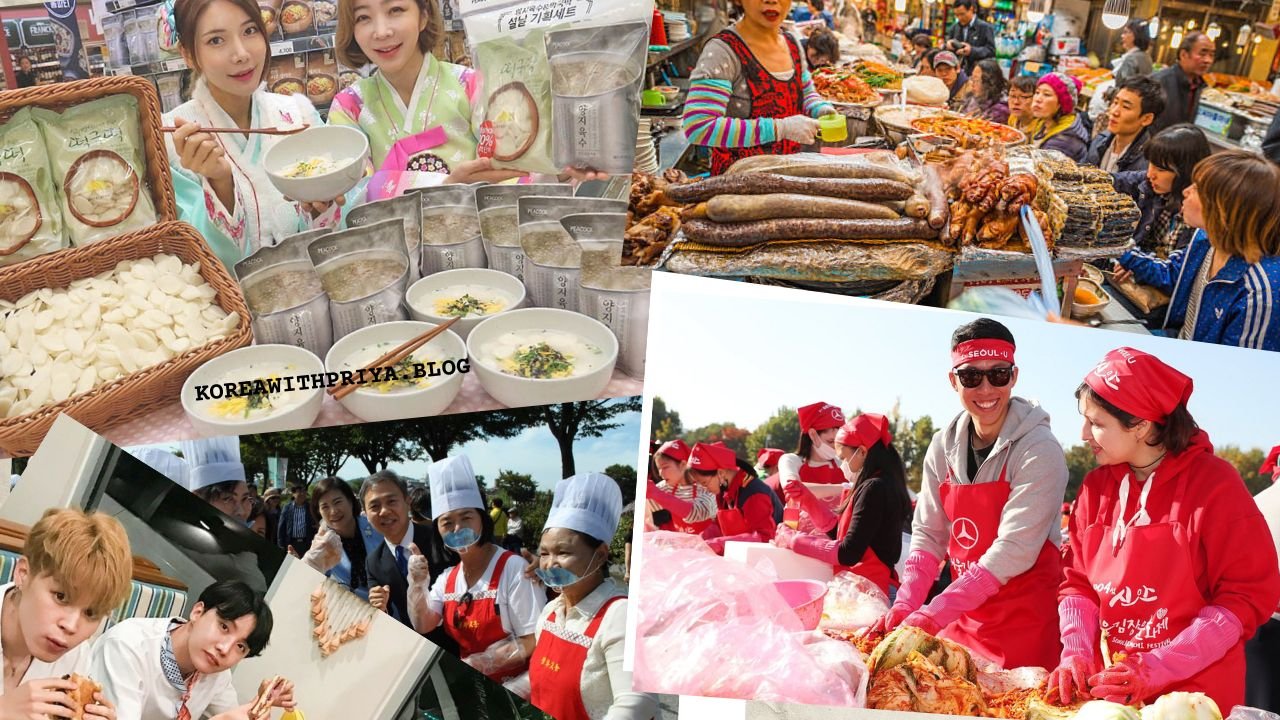Exploring Food Festivals and Events in South Korea
Introduction to South Korean Food Culture
South Korean food culture is known for its rich culinary heritage and the significant role food plays in Korean society. The cuisine of South Korea is diverse, vibrant, and deeply rooted in tradition. It reflects the country’s history, geography, and agricultural practices, resulting in a unique and flavorful culinary experience.
Table of Contents
The rich culinary heritage
Top 15 Best Traditional Korean Food in Seoul
South Korea boasts a culinary heritage that spans thousands of years. Traditional Korean cuisine, known as “hansik,” is characterized by a balance of flavors, colors, and textures. It emphasizes the use of fresh ingredients and a wide array of seasonings and condiments.
One of the key features of South Korean cuisine is the focus on fermentation. Fermented foods like kimchi, a spicy and tangy side dish made from fermented vegetables, are staples in Korean meals. Other fermented delicacies include doenjang (soybean paste), gochujang (red chili paste), and ganjang (soy sauce). These fermented ingredients add depth and complexity to Korean dishes.
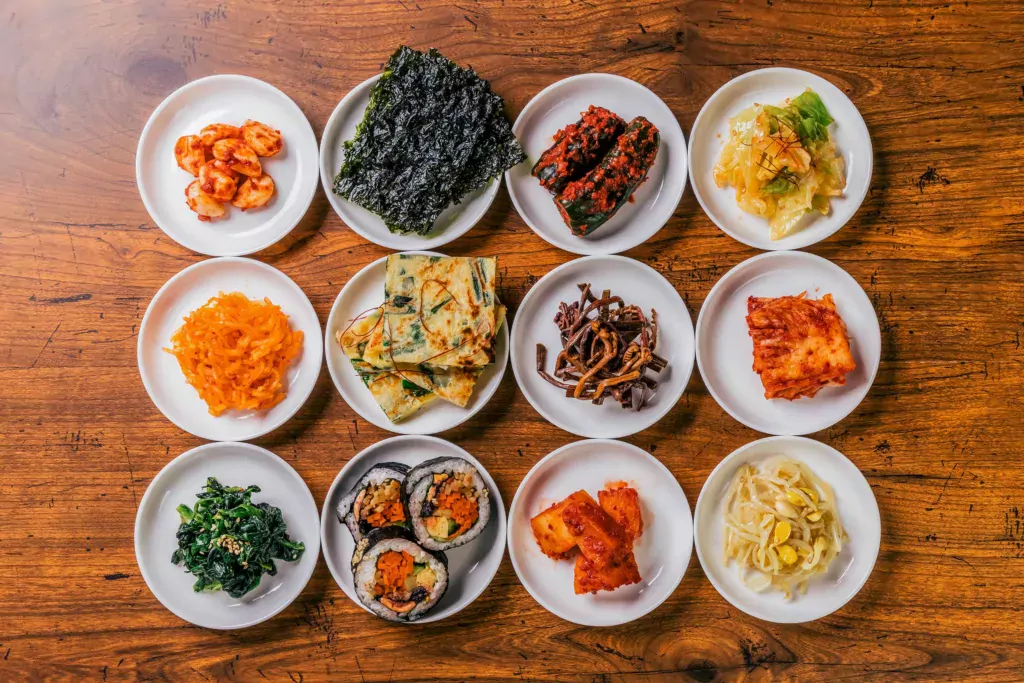
Rice is a fundamental component of Korean cuisine and is often served as the main staple. It is typically accompanied by a variety of side dishes called “banchan.” Banchan can include an assortment of vegetables, pickles, meat, fish, and tofu, providing a wide range of flavors and textures in a single meal.
Read more on Cultural Kaleidoscope: Between Indian and Korean Cultures
Role of food in Korean society
Food holds immense cultural and social significance in South Korea. It is not merely a means of sustenance but also a way to express love, respect, and hospitality. Sharing meals with family, friends, and colleagues is a cherished tradition in Korean society, fostering strong bonds and building relationships.
Korean meals are often communal, with dishes placed in the center of the table for everyone to share. This communal dining style promotes a sense of togetherness and encourages the practice of “jeong,” a Korean concept of deep affection and connection.
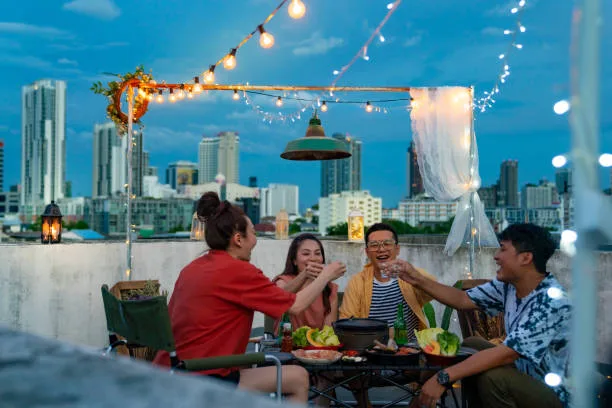
Food also plays a role in various cultural and celebratory events in South Korea. Festivals such as Chuseok (harvest festival) and Seollal (Lunar New Year) feature special dishes that are prepared and shared with loved ones as a way to celebrate and honor ancestral traditions.
Furthermore, South Korea takes pride in its unique dining etiquette. Respectful table manners, such as using chopsticks and spoons correctly, sharing food with others before serving oneself, and showing appreciation for the meal, are highly valued.
In recent years, South Korean cuisine, particularly Korean barbecue (samgyeopsal) and Korean fried chicken (yangnyeom tongdak), has gained international popularity, contributing to the global recognition of Korean food culture.
Significance of Food Festivals
Celebration of traditions and flavors
The celebration of traditions and flavors in South Korea is a captivating experience that showcases the rich cultural heritage of the country. The culinary traditions of South Korea are deeply rooted in history and reflect the unique flavors and cooking techniques that have been passed down through generations.
From the pungent and spicy kimchi to the savory and hearty bibimbap, each dish tells a story and represents a distinct regional specialty. Food festivals in South Korea provide a platform to honor and showcase these traditions, allowing locals and visitors alike to indulge in the vibrant flavors and immerse themselves in the cultural tapestry of the country. It’s a celebration that not only tantalizes the taste buds but also offers a deeper understanding and appreciation of South Korean heritage.
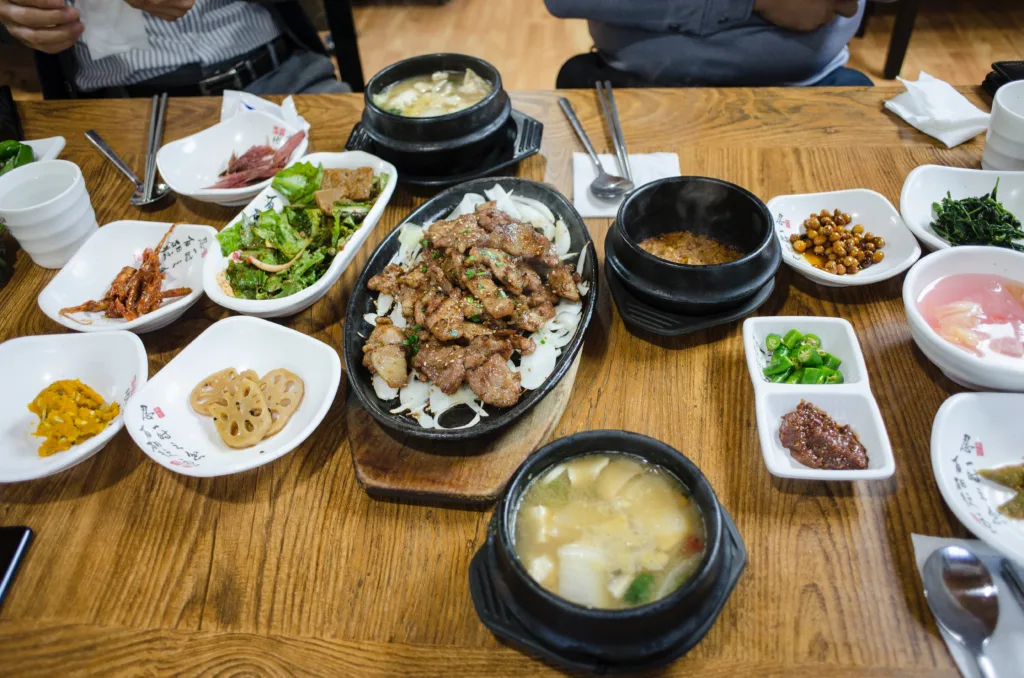
Boosting tourism and the local economy
South Korea’s vibrant food culture plays a significant role in boosting tourism and the local economy. The country’s unique flavors and culinary traditions attract food enthusiasts from around the world. Food festivals and events, such as the Busan International Seafood & Fisheries Expo and the Jeonju Bibimbap Festival, draw in large numbers of domestic and international tourists, contributing to increased tourism revenue.
Additionally, the popularity of South Korean cuisine has led to a rise in food-related businesses, including restaurants, street food vendors, and food tours. This growth in the food industry stimulates the local economy, creating employment opportunities and supporting local farmers, producers, and suppliers. The combination of cultural experiences and gastronomic delights has made South Korea a sought-after destination for food and travel enthusiasts.
Must-Try South Korean Dishes
Kimchi: A staple fermented delight
Kimchi is a staple fermented delight in South Korean cuisine. Made from fermented vegetables, such as cabbage and radishes, and seasoned with spices, garlic, and chili peppers, it offers a unique blend of tanginess, spiciness, and umami flavors. Kimchi is not only delicious but also rich in probiotics and nutrients, making it a beloved and healthy part of Korean meals.

Bibimbap: Harmony in a bowl
Bibimbap, a popular Korean dish, is often described as “harmony in a bowl.” It consists of a colorful assortment of vegetables, meat (optional), and a fried egg served on top of a bed of rice. The various ingredients complement each other, creating a balanced and flavorful combination that represents the essence of Korean cuisine.
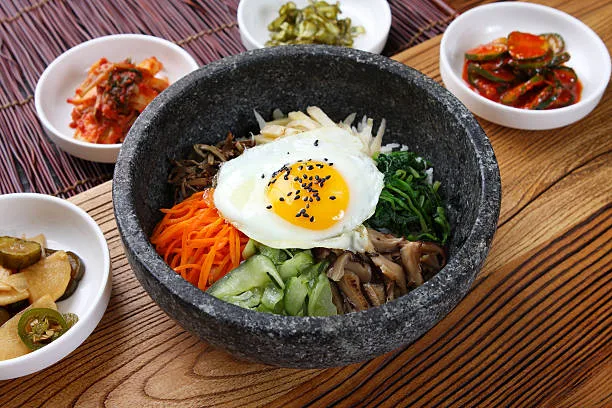
Bulgogi: Grilled marinated goodness
Bulgogi, a beloved Korean dish, is often described as “grilled marinated goodness.” Thinly sliced beef is marinated in a savory blend of soy sauce, garlic, sesame oil, and other seasonings before being grilled to perfection. The resulting dish is tender, juicy, and bursting with mouthwatering flavors, making it a true delight for meat lovers.

Diverse Regional Cuisines
Jeju Island’s seafood specialties
Jeju Island is famous for its abundant fresh seafood caught daily in local waters. Local specialties showcase the bounty of the sea. Sapphire-colored crab from the southern coasts is roasted whole with Korean red pepper paste for a mildly spicy flavor. Dolsot bibim nap or hot stone bean sprout rice mixes tender bean sprouts with in-shell baby shrimp, tuna, and seasonal vegetables.
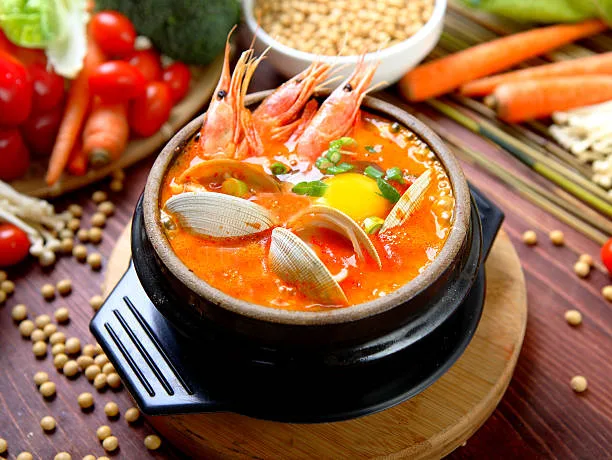
Grilled fish like mae-un or red seabream hit the grill topped with a blend of sesame oil, salt, and chili pepper for a hearty meal. Oceanside restaurants serve hanjeong uh or raw inch-long silversides marinated in sesame oil and salt as banchan. Jeju’s coastal landscapes and seas yield globally recognized specialties celebrating the island’s connection to the sea.
Andong’s traditional mask dance festival and cuisine
Andong is renowned for its Talchum mask dance festival held each fall. During the celebrations, talented masked dancers perform stories and myths to the beats of drums and gongs. Their elaborate hand-carved masks can take a year to create and each depicts different characters. The festival is coupled with the humble pleasures of Andong’s local cuisine.

Hot stone stews bubbling with chicken, eggs, and napa cabbage warm the soul. Andong naengmyeon, mul-gimchi, and dongdongju provide a refreshing contrast to the spicy stews. Steamed bowls of the local cold noodles made from strained potato starch are especially soothing to enjoy alongside the ephemeral dancing masks telling timeless folktales of Korea’s history and culture.
Key Ingredients and Flavors
Gochujang: The spicy essence
Gochujang is the fiery essence of Korean cooking. This versatile red chili paste made from fermented soybeans, rice, and copious chilies lends heat and robust flavor to countless dishes. After months of aging in earthen pots, the gochujang develops a deep, rich savoriness from the blended ingredients.
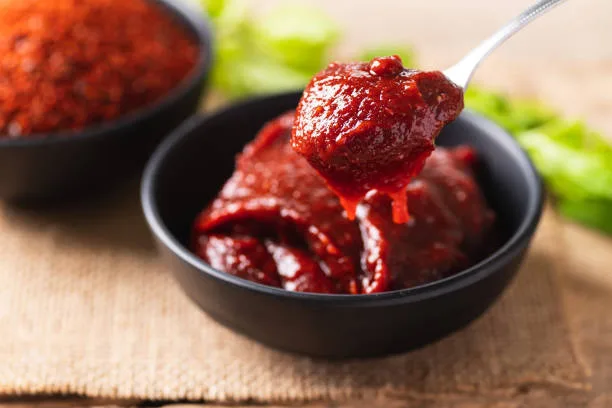
Even a spoonful unleashes layers of spicy, warm complexity. It acts as the base for beloved dishes like bibimbap, adding crave-worthy warmth. Gochujang also joins forces with garlicky samgeopsal or tenderizes the spicy grilled chicken. This spicy umami condiment has anchored Korean home cooking for centuries, infusing everyday meals with a memory-evoking fiery soul.
Sesame and perilla: Nutty and aromatic notes
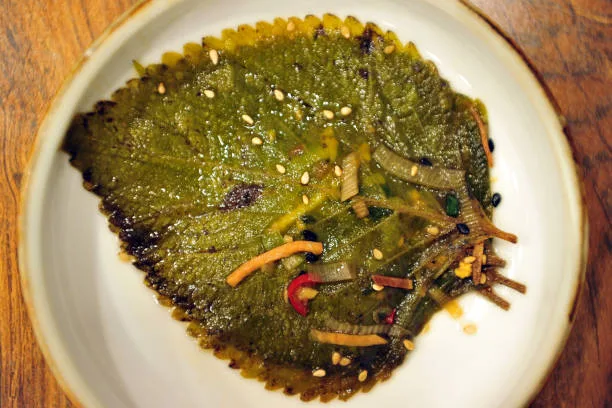
Sesame and perilla, both renowned for their nutty and aromatic profiles, offer a tantalizing sensory experience. Sesame seeds boast a delicate crunch and a rich, toasted nuttiness, elevating dishes from salads to stir-fries. Perilla, on the other hand, imparts a unique fragrance reminiscent of mint, basil, and anise. Its leaves release an enchanting aroma, enhancing culinary creations and infusing a distinct character into traditional recipes. Together, sesame and perilla awaken the palate with their delightful symphony of flavors, enhancing dishes with their captivating blend of nutty essence and aromatic allure.
Iconic Food Festivals
Jeonju Bibimbap Festival
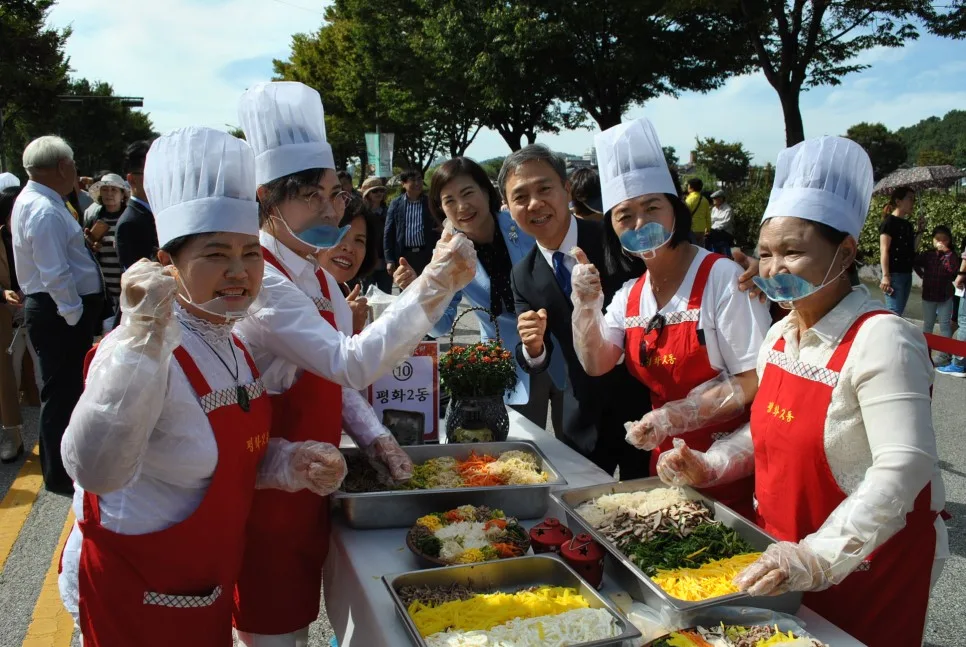
The Jeonju Bibimbap Festival, a vibrant celebration of South Korea’s iconic dish, Bibimbap, is a captivating cultural event. Held annually in Jeonju, the festival pays homage to this colorful rice bowl adorned with an array of fresh ingredients. The event is a culinary delight, featuring diverse Bibimbap variations that showcase regional flavors and creativity. Visitors immerse themselves in cooking competitions, food stalls, and cultural performances, gaining a deeper understanding of Korean gastronomy. Through this festival, the rich heritage of Bibimbap is celebrated, fostering a shared love for food and tradition among locals and global attendees alike.
Jinju Namgang Yudeung Festival (Lantern Festival)
The Jinju Namgang Yudeung Festival, known as the Lantern Festival, illuminates South Korea’s cultural tapestry with its enchanting spectacle. Set in Jinju, the festival honors historical significance, commemorating a 16th-century battle. The city’s Namgang River becomes a mesmerizing canvas as thousands of colorful lanterns light up the night sky, reflecting on the water’s surface.

The event fosters a serene ambiance, blending tradition with modernity through lantern-making workshops, parades, and performances. Visitors from around the globe are drawn to this captivating showcase of artistry and heritage, fostering cross-cultural connections and a sense of wonder under the radiant glow of the Jinju Lantern Festival.
Seasonal Delights
Bounties of spring: Cherry blossoms and food
In South Korea, the bounties of spring weave a captivating tale as cherry blossoms blanket the land in ethereal beauty. Beyond the visual splendor, these delicate blooms inspire a culinary symphony. Streets come alive with cherry blossom festivals, where traditional and modern dishes infused with floral essence take center stage.

From pink-hued rice cakes to cherry blossom teas, the nation’s cuisine is transformed into a fragrant masterpiece. As petals gently fall, South Korea’s cherished tradition of admiring these blooms known as “벚꽃보리” (beotkkot bori) converges with delectable flavors, harmonizing nature’s spectacle with the tantalizing allure of cherry blossom-infused delicacies.
Savoring summer: Patbingsu and refreshing treats
Embracing summer, South Korea delights in savoring Patbingsu and an array of refreshing treats. Patbingsu, a beloved shaved ice dessert, offers respite from the heat with its mountainous ice shavings adorned with sweet red beans, fruits, and condensed milk. Streets brim with vendors offering icy pleasures like watermelon slices on sticks and tangy bingsu varieties.
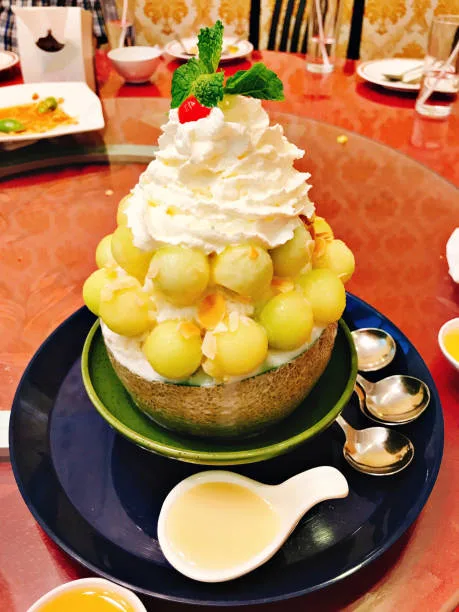
The vibrant flavors echo the season’s energy, while traditional tea houses provide serene havens for cooling down. As the sun-kissed days unfold, South Koreans relish these cool indulgences, turning the sweltering summer into a season of culinary delights that evoke both tradition and innovation.
Autumn Harvest Celebrations
Gangjin Celadon Festival
The Gangjin Celadon Festival, an exquisite celebration held in South Korea, pays homage to the nation’s rich ceramic heritage. Set in Gangjin, a historic hub of celadon pottery, the festival showcases masterpieces of delicate green-glazed ceramics. Visitors witness the intricate art of crafting celadon, partake in hands-on workshops, and explore ancient kiln sites.
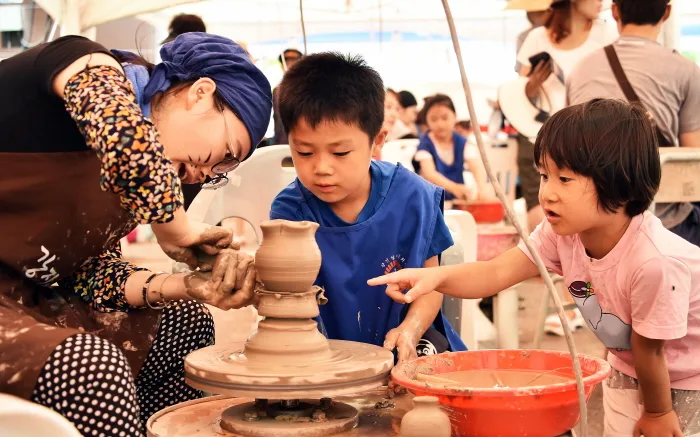
The event weaves tradition and modernity, featuring cultural performances and art exhibitions. As the town is adorned with stunning celadon creations, this festival illuminates the enduring beauty of Korean craftsmanship, inviting locals and global attendees to immerse themselves in the world of timeless artistry.
Andong Mask Dance Festival and traditional fare
The Andong Mask Dance Festival in South Korea transports visitors to a realm of captivating traditions. Against the backdrop of the city’s historic sites, vibrant mask dances enliven the streets, recounting folklore and tales. Amid this cultural tapestry, traditional fare takes center stage.
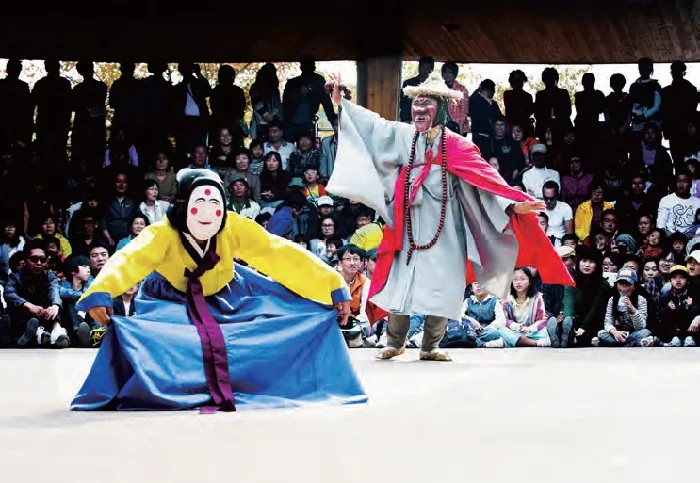
Street vendors offer savory delights like Andong Jjimdak, a succulent braised chicken dish, and Heotjesabap, a flavorful meal of rice and assorted side dishes. As the rhythmic dances unfold, the tantalizing aromas of these local delicacies infuse the air, creating a multisensory experience that celebrates both the artistry of dance and the culinary heritage of Andong.
Embracing Winter Flavors
Gwacheon Festival of Light and Ice Sculptures
The Gwacheon Festival of Light and Ice Sculptures in South Korea casts a spellbinding winter enchantment. Set against the night sky, intricate ice sculptures illuminate the landscape with a kaleidoscope of colors, blending traditional motifs with modern artistry. Visitors wander through a surreal world of frozen wonders, while light installations add a touch of magic.
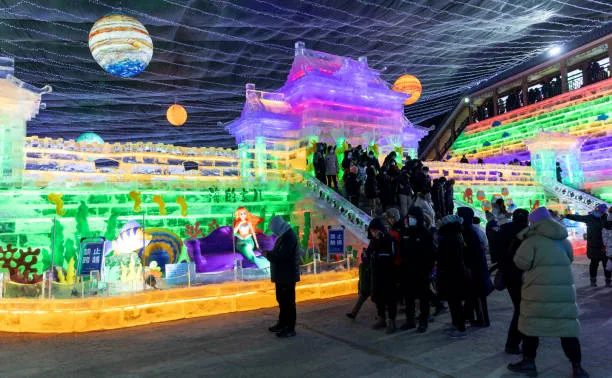
The festival’s charm is enhanced by a medley of seasonal treats such as hotteok, a sweet pancake, and odeng, a skewered fish cake. This convergence of frosty artistry and delectable flavors creates an immersive experience that captures the heart of South Korea’s winter wonderland.
Lunar New Year’s Tteokguk (rice cake soup)
Lunar New Year’s Tteokguk, a cherished South Korean tradition, symbolizes renewal and prosperity. This hearty rice cake soup, simmered with clear broth and delicate slices of cylindrical rice cakes, holds cultural significance as a symbol of aging another year. Families gather to share this dish, which is believed to grant good fortune.

The tender rice cakes represent harmony and unity, while the act of consuming Tteokguk signifies embracing the new year’s challenges. Topped with colorful garnishes like egg, seaweed, and beef, this soup not only warms the body but also nourishes the soul with its deep-rooted symbolism and delicious flavors.
Street Food Extravaganza
Myeongdong Street Food Market
The Myeongdong street food market in Seoul, South Korea, is a bustling haven for gastronomic exploration. Nestled in the heart of the city, this vibrant market lures visitors with an array of delectable treats. From piping-hot tteokbokki (spicy rice cakes) to crispy odeng (fish cake skewers), an eclectic selection of Korean street food delights the senses.

Aromas of sizzling meat skewers and sweet pancakes fill the air as vendors showcase their culinary expertise. Amid the dynamic energy of shopping and entertainment, Myeongdong street food market offers a mouthwatering journey through Korea’s culinary landscape, captivating both locals and tourists alike.
Tongin Market’s dosirak experience
Tongin Market’s dosirak experience in Seoul, South Korea, is a nostalgic culinary journey. Visitors purchase old-fashioned coins to exchange for traditional lunch boxes filled with an assortment of banchan (side dishes) from various stalls. The vibrant market brims with vendors offering kimchi, dumplings, and more. This unique self-assembled dosirak allows patrons to curate their meals, reminiscent of school days.
As they stroll through the market, selecting dishes that intrigue them, a sense of connection to Korean culture and flavors blooms. The Tongin Market dosirak captures the essence of community and offers a taste of history, one delicious bite at a time.
Fusion Food Trends
Global influences on Korean cuisine
Korean cuisine is a dynamic and rich culinary tradition that has been influenced by various global factors throughout its history. These influences have contributed to shaping the flavors, ingredients, and cooking techniques that define Korean food today. Here are some of the notable global influences on Korean cuisine:
- Chinese Influence: One of the earliest and most significant influences on Korean cuisine came from China. Trade and cultural exchanges between the two nations led to the introduction of various ingredients such as soy sauce, tofu, and noodles. These ingredients were integrated into Korean dishes, resulting in a unique fusion of flavors and culinary techniques.
- Mongolian Influence: During the Mongol invasions of Korea in the 13th century, there was an exchange of culinary knowledge. Korean cuisine adopted Mongolian techniques for grilling meat, which eventually evolved into the popular Korean barbecue style of cooking.
- Japanese Influence: Korea’s proximity to Japan has also played a role in shaping its cuisine. The Japanese occupation of Korea in the early 20th century led to the incorporation of certain Japanese ingredients and cooking methods. For instance, certain types of sushi and tempura have found their way into Korean cuisine.
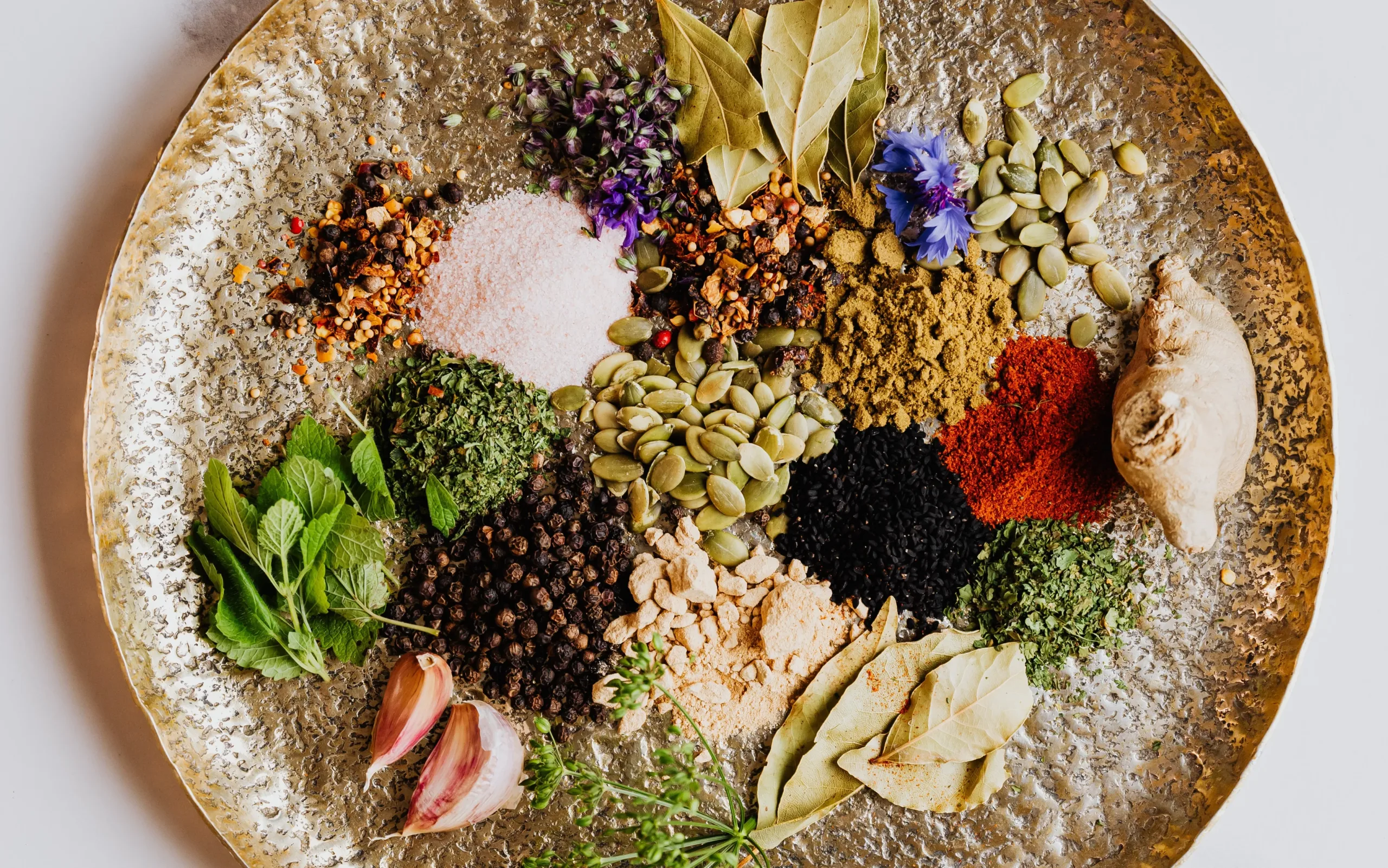
- American Influence: After the Korean War, the presence of American military bases introduced Western ingredients like beef and dairy products to the Korean diet. This influence gave rise to dishes like bulgogi (marinated grilled beef) and creamy carbonara-style pasta with a Korean twist.
- Globalization and Trade: With the rise of globalization and international trade, Korean cuisine has been exposed to various ingredients and cooking techniques from around the world. Fusion dishes that combine Korean flavors with elements from other cuisines have become more prevalent.
- Tourism and Cultural Exchange: The increasing popularity of Korean pop culture (K-pop) and dramas has led to a surge in global interest in Korean cuisine. As a result, more people are seeking out and experimenting with Korean dishes, leading to a broader appreciation of the cuisine worldwide.
- Health and Wellness Trends: Korean cuisine, with its emphasis on vegetables, fermented foods (like kimchi), and balanced flavors, has aligned well with the global trend toward healthier eating. This has led to a growing interest in Korean dishes that are considered both flavorful and nutritious.
- Migration and Diaspora: Korean communities around the world have adapted their cuisine to local ingredients and palates, leading to the creation of dishes that are uniquely Korean but influenced by the available resources and cultural preferences of their new homes.
Tapping into international food trends
South Korea has adeptly tapped into international food trends, creating a culinary fusion that captivates global palates. By infusing traditional dishes with modern twists and embracing health-consciousness, Korean cuisine has gained international acclaim. Iconic foods like kimchi and bulgogi have become sought-after superfoods and flavor enhancers, while Korean barbecue’s interactive dining experience appeals to social media-savvy diners. Street food markets and innovative cafes offer experiential delights like bingsu (shaved ice dessert) and trendy flavored teas. Through skillful adaptation and a deep respect for its roots, South Korea continues to set the table for global gastronomic enjoyment.
Cooking Workshops and Demonstrations
Learning the art of kimchi-making
Discovering the art of kimchi-making unveils a journey into Korean culinary tradition. This centuries-old practice involves precision and patience as fresh vegetables meld with a blend of spices, garlic, and ginger. Cabbage leaves are massaged with a fermented paste, creating a harmonious marriage of flavors. The process, often passed down through generations, is a hands-on exploration of cultural heritage.
As the mixture ferments, its taste transforms from pungent to tangy, offering a glimpse into Korea’s palate. Learning kimchi-making not only imparts culinary skills but also fosters a connection to the country’s history and the profound essence of its cuisine.
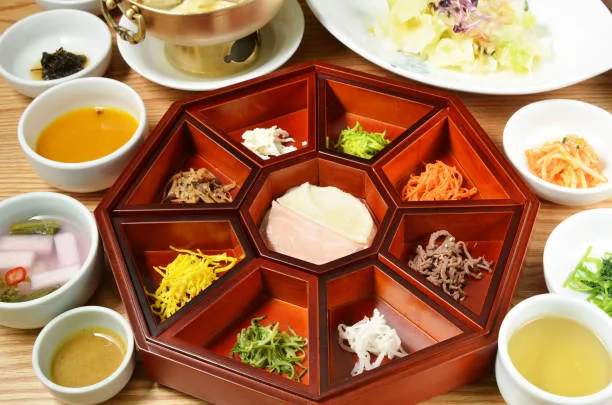
Mastering the art of royal court cuisine
Mastering South Korea’s royal court cuisine is a voyage into culinary refinement. Rooted in centuries of tradition, this artistry embodies meticulous preparation and elegant presentation. Drawing from seasonal ingredients, each dish reflects a harmonious balance of colors, flavors, and textures. Recipes, often guarded secrets, are meticulously passed through generations.
The result is a symphony of flavors fit for kings, marked by subtle yet profound tastes. Learning this art involves not only cooking techniques but also an appreciation for history and culture. To master royal court cuisine is to unlock a time-honored legacy, preserving the essence of Korea’s regal gastronomy.
Exploring Local Food Markets
Noryangjin Fish Market
Noryangjin Fish Market in South Korea stands as a bustling seafood haven, captivating both locals and visitors. Nestled in Seoul, it’s a vibrant sensory experience where rows of stalls boast an array of fresh catches from the sea. From prawns to octopus, the market showcases South Korea’s rich maritime culture. Patrons can select their preferred seafood, and then head to nearby restaurants to have it expertly prepared.

The market’s lively atmosphere, brimming with sights and aromas, offers an authentic taste of Korean gastronomy. Noryangjin Fish Market is a must-visit destination where the ocean’s bounty takes center stage.
Gwangjang Market’s vibrant food scene
Gwangjang Market, a vibrant gem in South Korea’s culinary landscape, boasts a kaleidoscope of flavors and aromas. Located in Seoul, it’s a sensory journey where traditional Korean street food takes the spotlight. Stalls serves up delectable delights like bindaetteok (mung bean pancakes), tteokbokki (spicy rice cakes), and savory gimbap (rice rolls). The market’s historical charm is palpable as visitors weave through narrow alleys, savoring authentic tastes passed down through generations.

Gwangjang Market’s bustling energy, combined with its array of mouthwatering treats, provides an immersive experience of South Korea’s culinary heritage, making it an essential destination for food enthusiasts.
The Rise of Vegan and Healthy Options
Temple food and its benefits
Temple food in South Korea embodies a holistic culinary philosophy that nurtures both body and spirit. Rooted in Buddhist traditions, it celebrates simplicity and mindfulness, using fresh, plant-based ingredients to create dishes that harmonize with nature. This cuisine not only promotes physical well-being but also encourages mental clarity. The focus on balance and restraint results in dishes that are flavorful, nutritious, and aesthetically pleasing.
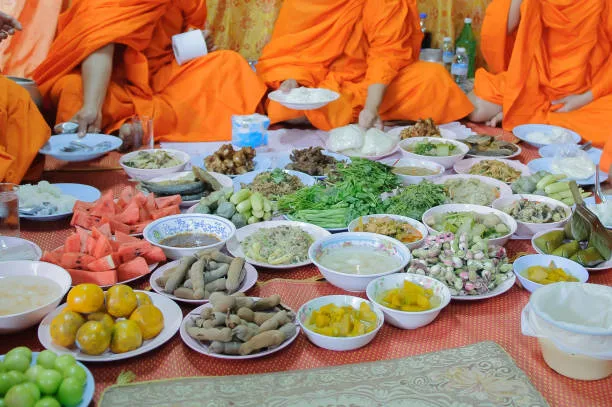
Temple food’s benefits extend beyond the table, offering a pathway to mindful eating and a deeper connection to one’s surroundings. It’s a culinary journey that nourishes both the body and the soul, fostering harmony and inner peace.
Vegan food festivals promoting wellness
Vegan food festivals in South Korea are vibrant celebrations of wellness and conscious living. These events showcase a diverse array of plant-based delicacies that reflect the country’s growing interest in health and sustainability. From creative twists on traditional dishes to innovative international flavors, the festivals inspire mindful eating and showcase the benefits of a vegan lifestyle.
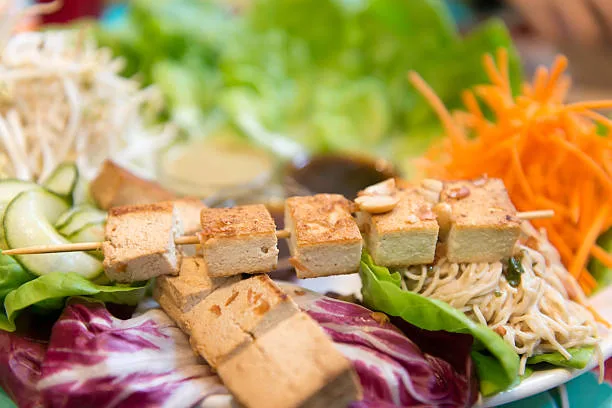
As a fusion of culinary artistry and well-being, these gatherings promote community, education, and a deeper connection to the environment. Through vegan food festivals, South Korea is fostering a culture of nourishment that aligns with global trends toward healthier, ethical choices.
Engaging in Food-Related Competitions
Kimchi-eating contests
Kimchi-eating contests in South Korea add a zesty twist to the country’s culinary culture. These spirited events celebrate the beloved national dish, challenging participants to consume as much kimchi as possible within a set time. With its bold flavors and rich nutritional value, kimchi takes center stage in these competitions, reflecting Koreans’ love for their iconic fermented side dish.
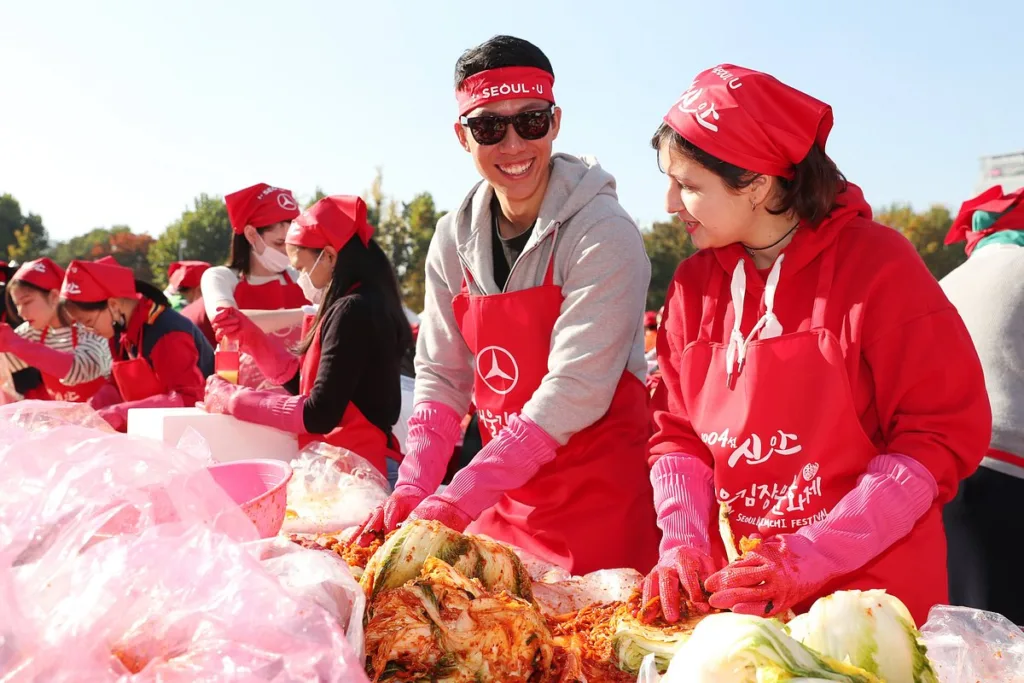
Beyond the friendly rivalry, these contests embody a cultural connection to food, fostering camaraderie and showcasing the boundless enthusiasm Koreans have for their heritage. Kimchi-eating contests are a spicy and fun way to bring people together in the name of tradition and gastronomic delight.
Cooking challenges showcasing local ingredients
South Korea’s cooking challenges spotlight regional flavors through inventive culinary competitions. These contests invite chefs and enthusiasts to craft delectable dishes using locally sourced ingredients. From mountains to seas, each dish tells a story of the area’s natural bounty. As participants blend tradition with innovation, these challenges celebrate Korea’s diverse terroir while inspiring creativity. With each plate, a homage to local ingredients emerges, fostering culinary appreciation and connecting people to the country’s rich gastronomic heritage.
Food Festivals’ Role in Korean Tourism
Attracting international visitors
Food festivals play a pivotal role in Korean tourism by captivating international visitors with a delectable journey through the nation’s cuisine. These events showcase a kaleidoscope of flavors, offering a firsthand experience of iconic dishes and regional specialties. From vibrant street food festivals to refined culinary showcases, they celebrate Korea’s gastronomic diversity.
As travelers savor authentic kimchi, bibimbap, and barbecue, they not only indulge their taste buds but also immerse themselves in the country’s culture and traditions. Food festivals become a gateway to Korean hospitality, fostering memorable encounters and enticing visitors to explore the rich tapestry of Korea’s culinary landscape.
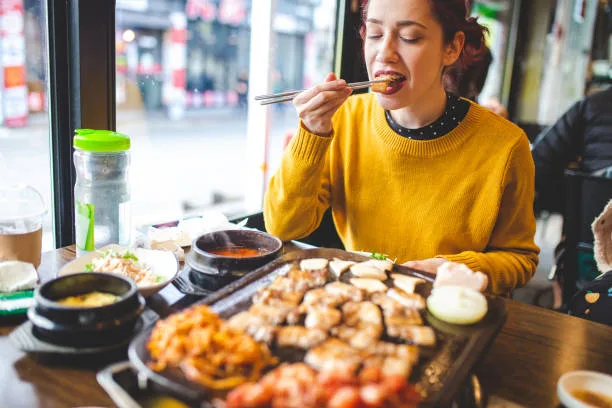
Showcasing South Korea’s modernity and tradition
South Korea masterfully showcases both modernity and tradition, creating a captivating juxtaposition. Gleaming skyscrapers and advanced technology stand alongside ancient temples and historic palaces. The K-pop phenomenon and traditional performances share the stage, reflecting the nation’s dynamic cultural evolution.
From cutting-edge cuisine to time-honored rituals, South Korea seamlessly intertwines its rich heritage with forward-thinking innovation, offering visitors a multifaceted experience that bridges the gap between past and present.
Summary: Savoring South Korea’s Culinary Extravaganza
Capturing the essence of tradition and innovation
Savoring South Korea’s Culinary Extravaganza” allows travelers to embark on a flavorful journey through a nation that harmonizes tradition and modernity. From bustling markets to elegant restaurants, the cuisine reflects a rich tapestry of influences. Traditional dishes like kimchi and bulgogi coexist with innovative street food and fusion creations. Food festivals and challenges spotlight local ingredients and foster a deep connection to Korean culture. These gastronomic experiences, ranging from royal court cuisine to vegan delights, offer more than just taste; they intertwine with history and showcase the heart of a country where food is a gateway to both its heritage and contemporary vibrancy.”
